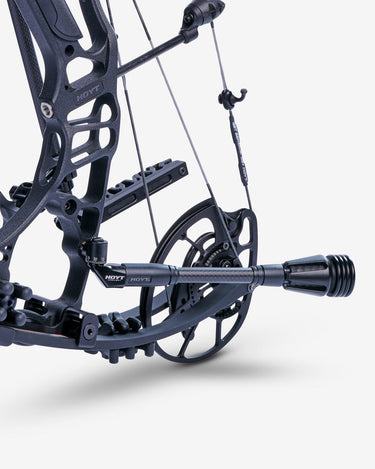Bow Stabilizer Buying Guide: Everything You Need to Know Before You Buy
Bow Stabilizer Buying Guide: Everything You Need to Know Before You Buy
Blog Article
Maximize Your Archery Precision With These Bow Stabilizer Techniques
One vital element that can considerably impact your performance is the appropriate usage of bow stabilizers. Whether you are a seasoned archer looking to improve your abilities or a newbie excited to enhance your accuracy, grasping these bow stabilizer strategies might be the trick to hitting your mark with unrivaled uniformity.
Advantages of Utilizing Bow Stabilizers
Utilizing bow stabilizers can considerably boost an archer's precision and overall efficiency by lessening bow torque and vibration. Bow torque, caused by the unequal distribution of weight in the bow, can bring about variances in shot placement. By affixing a bow stabilizer, the weight is redistributed, lowering the impacts of torque and helping the archer attain a more consistent shot. Additionally, bow stabilizers wet vibration, which not just improves the convenience of shooting yet also prevents the bow from leaping upon release, therefore aiding in preserving proper goal.
Furthermore, bow stabilizers can help in holding the bow constant, especially throughout gusty problems or when shooting from longer distances. The added weight at the front of the bow gives security and equilibrium, allowing the archer to focus on intending without the distraction of bow motion. In general, the advantages of making use of bow stabilizers extend beyond just accuracy, improving the archer's experience and efficiency in numerous shooting scenarios.
Selecting the Right Bow Stabilizer
Picking the appropriate bow stabilizer is vital for maximizing your archery tools and improving shooting performance. When choosing a bow stabilizer, there are several elements to consider to ensure you find the best fit for your requirements. Take into consideration the weight of the stabilizer. Larger stabilizers can assist minimize bow torque and take in even more resonance, bring about a steadier purpose. However, lighter stabilizers offer even more ability to move, which can be beneficial in certain shooting situations.

Finally, take into consideration the style of the stabilizer. Some stabilizers feature flexible weights or dampeners that enable you to customize the balance and feeling of your bow. Inevitably, choosing the ideal bow stabilizer includes finding a balance between weight, length, style, and product to enhance your shooting precision and total efficiency.
Appropriate Installment Strategies
To make certain optimum efficiency and safety and security in archery, grasping appropriate installment strategies for your bow stabilizer is essential. The first step in mounting a bow stabilizer is to recognize the proper positioning on your bow.
Following, safely attach the stabilizer to the bow using the ideal installing hardware. Some stabilizers come with flexible weights that can be included or removed to adjust the equilibrium of your bow.

Changing Stabilizer Weight and Size
After ensuring the appropriate setup of your bow stabilizer, the following action involves adjusting the weight and length to enhance its efficiency in enhancing archery accuracy. The weight of the stabilizer plays a vital duty in minimizing bow movement during the shot cycle. Adding weight to the stabilizer can assist moisten resonances and boost stability, causing even more regular and exact shots. On the various other hand, reducing the weight can increase maneuverability, which is useful for circumstances needing quick target acquisition.
When it concerns stabilizer size, locating the right balance is essential. A longer stabilizer can give greater stability by raising the range in between the bow and the weight at the end of the stabilizer. This added distance boosts the supporting result, specifically in windy conditions or when contending longer ranges. Conversely, a much shorter stabilizer provides extra ability to move and may click for source be favored by archers who value agility and fast activities throughout capturing.
Advanced Stabilizer Tuning Tips
Achieving optimal bow security and accuracy in archery demands a nuanced approach to advanced stabilizer adjusting. Advanced stabilizer tuning entails fine-tuning different components to improve the bow's equilibrium, lower resonance, and boost general accuracy.
An additional crucial element of innovative stabilizer tuning is enhancing the damping residential or commercial properties of the stabilizer system. This can be achieved by incorporating additional dampening accessories such as rubber dampeners or harmonic stabilizers to additionally minimize resonance and sound. Exploring different materials for the stabilizer construction, such as carbon fiber or light weight aluminum, can additionally affect the bow's efficiency by modifying its weight circulation and rigidity. By carefully fine-tuning these advanced stabilizer components, archers can maximize their accuracy and uniformity on the variety or in competitors.
Conclusion
In conclusion, maximizing archery precision can be achieved via the proper option, setup, and adjustment of bow stabilizers. Generally, incorporating bow stabilizers right into archery practice can lead to enhanced efficiency and enhanced precision.
Using bow stabilizers can dramatically improve an archer's precision and overall efficiency by minimizing Recommended Site bow torque and vibration. Longer stabilizers give greater security and equilibrium, especially for long-distance capturing, while much shorter stabilizers provide more flexibility and are easier to navigate in tight rooms (bow stabilizer). Carbon fiber stabilizers are lightweight and sturdy, while light weight aluminum stabilizers are durable and provide exceptional resonance wetting
A longer stabilizer can provide higher security by raising the distance in between the bow and the weight at the end of the stabilizer.An additional crucial element of sophisticated stabilizer adjusting is maximizing the damping residential properties of the stabilizer system.
Report this page